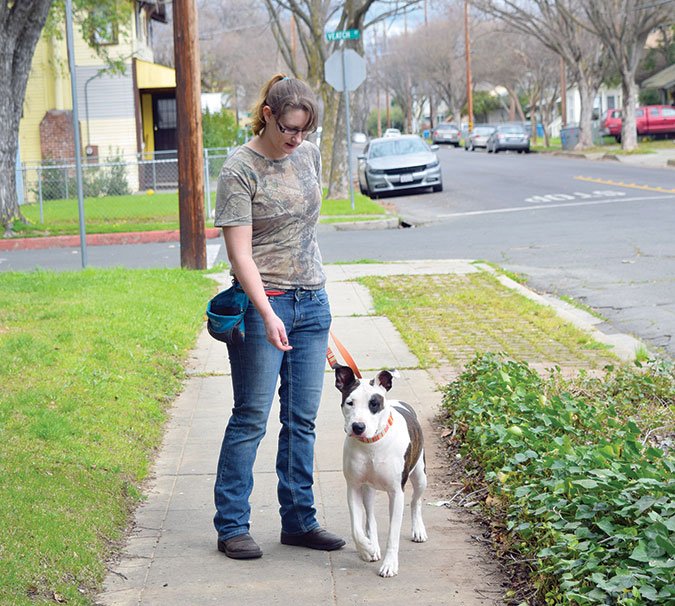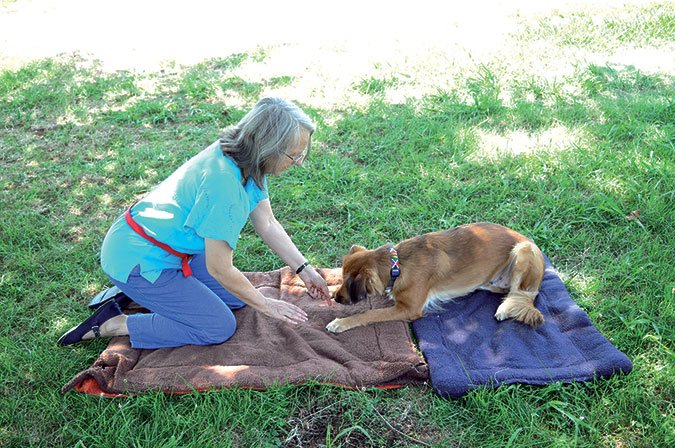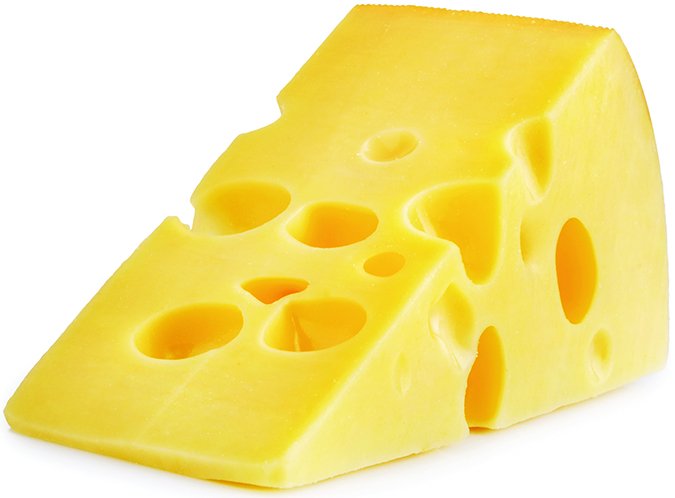[Updated December 26, 2018]
Dogs sometimes don’t do what we ask them to do. Annoyed, we might repeat a cue several times – louder and a little more sternly each time – usually with very little effect. “Fido, come here. Fido. Come. FIDO. I said here! COME! I mean it!”
We all do it. I once heard someone threaten to count to three – or else! (It didn’t work.) Often, the dog is then labeled as “stubborn.” It’s easy to think that’s the reason he “won’t listen.” I get it. It does kind of look like your dog is blowing you off. You ask him to come to you, and he just lies there, looking at you without budging. Or he might engage in a game of “Chase me!” Another time, you ask him to sit, and instead he stands and looks away. Or worse, he walks off. You may think, “But he knows this. He’s doing it on purpose!”
Well, there are better explanations why this happens, and your dog being stubborn or willful isn’t one of them. Possible causes can include simple things: Your dog may be suffering back pain and is trying to avoid activities that trigger his back pain, like jumping onto a high car seat. It may be that whatever you’re using as a reinforcer is not valuable enough to your dog; a few pieces of dry kibble can’t compare with the thrill of barking at a taunting squirrel on the back fence.

Of all the possible reasons for a dog’s failure to “listen,” three of them seem to come up consistently in my practice.
Reasons Dogs Don’t Listen:
– The dog isn’t even aware he’s been asked to do something.
– The dog doesn’t understand what he’s being asked to do.
– The cue you’re using has been “poisoned.”
Thankfully, there is something you can do about it. With a little investigation into understanding what’s happening and some easy training, you can polish your cues and improve the communication between you and your dog.
1. The Dog isn’t aware he’s been asked to do something.
I once visited a friend at her house, where I was greeted at the door by her dog, Bella. Bella was looking up at me excitedly, her tail was wagging, and it was evident she was getting ready to jump up on me. My friend noticed this and pre-emptively asked Bella to sit. “Sit. Sit. Sit!” Her cues were ignored and sure enough, Bella jumped up. My friend’s efforts became more hurried: “SIT! SIT!” She apologized to me and gently helped her dog down by using her hands.
At that moment I decided to do a little experiment. I explained that I would walk outside and come back in. Instead of just saying the “sit” cue, I asked my friend to say her dog’s name, make sure she had Bella’s attention, and then ask her to sit. I walked in as planned, my friend called out her dog’s name to get her attention, and when Bella glanced in her direction (it was barely a nano-glance, but it was there), she asked her to sit, which Bella did.
We often assume that when we utter a cue, our dogs know it’s meant for their ears. How are they to know? It’s our job to make it clear we’re addressing them before asking them to do something. Imagine waiting in a restaurant lobby for a table along with several other groups of people who are also waiting for a table. The hostess comes out, grabs a few menus, and announces to no one in particular, “Follow me, please.” Who is she talking to? Unsure, the people in the lobby would probably just stay put and wait for clarification. Half the group may not even be aware that the hostess has said anything at all!
You can let your dog (or anyone) know you’re addressing him by offering direct eye contact before speaking. Better yet, say his name first. Best, say his name, wait for confirmation he’s heard you, then say what you want to say. In the case of giving your dog a cue, say your dog’s name and wait until your dog either turns toward you or, if he’s very focused on something else, at least watch for a quick ear flick in your direction that indicates he’s aware that you’re speaking to him.
This is an especially handy habit to get into if there are multiple dogs sharing your home. Saying the dog’s name first lets that dog know that what follows is intended for him.
So, if your dog appears to be particularly distracted by something and you want to call him over to you, say his name first. You may need to add some kissy sounds or whistle, too. Wait for confirmation that he heard you, however fleeting, and then give him your recall cue.
2. The dog doesn’t understand want you want from him.
This means exactly what it sounds like. Your dog simply doesn’t know the cue as well as you think he does.
If you ask your dog to do something and he gets it right some of the time, it doesn’t necessarily mean that he’s deliberately choosing not to do it the rest of time. It’s entirely possible that when he got it right, he was just guessing. By doing exactly what you had asked him to do, it appeared as though he was responding to your cue because he “understood” it. Seen this way, it’s easy to assume that his occasional lack of response is some sort of defiance!
This is easy enough to fix with some fun training sessions. Even though you may think your dog “knows” a certain behavior, start as though you are teaching your dog the behavior for the very first time.

Let’s take “Down” as an example. A training plan for teaching “Down” might look like this:
a) With your dog sitting facing you, take one treat and hold it to your dog’s nose with your palm facing down.
b) Without saying anything, slowly lower your hand toward the floor in a straight vertical line, luring your dog’s snout to follow it. Your dog’s butt should remain on the floor. If he stands up, you may be moving your hand too quickly. Have him sit and begin again, more slowly.
c) When your hand reaches the floor, slowly move it along the floor, horizontally and toward you. You will have shaped a letter “L” from snout to floor, and from your dog’s body toward you. The idea is to get your dog to keep following the treat with his nose, bend down toward the floor, and then, while following your hand on the floor, stretch his front legs out to lie down.
d) The second his elbows touch the floor and he is in a down position, “mark” the correct behavior with the click of a clicker or a verbal marker (such as the word “Yes!”) and deliver a treat to him on the floor between his front legs. I prefer to deliver the treat on the floor instead of directly into the dog’s mouth, because it encourages him to hold the down position. If, after a few repetitions, he expects the treat to be delivered on the floor between his front legs, he’ll resist the temptation to stand up and reach for it in my hand.
e) Repeat this sequence two or three more times, and then quickly follow up with the exact same exercise, but with an empty hand (no treat/lure). When he reaches the down position, say “Yes!” before you reach for a treat and deliver it to him between his front paws.
f) Repeat this sequence with an empty hand several more times. You are teaching him the body language/hand signal for the down behavior.
Note that you have not yet given a verbal cue of “Down,” you’re just using a hand gesture at this point. Even if this seems like too simple an exercise for you and your dog, remember that you are going back to square one with this training exercise in an effort to start fresh. Only when this exercise is going well and your dog is consistently following your hand gesture is it time to add a verbal cue.
g) Say your dog’s name, followed by the word “Down” (or whatever other word you want to use as a cue). After you’ve said his name and given your verbal cue – and not until you’ve finished saying it – do your hand gesture, from snout level to the floor. At this point, you might not need to slowly move your hand horizontally to illustrate the bottom part of the letter “L.” Once you’ve moved your hand to the floor, pause and wait to see if your dog will lie down. Give him a moment to think about it, if necessary. Keep your eyes on the floor in front of him (don’t stare him in the eye).
It’s important not to say the cue and do the gesture simultaneously. You want your dog to build an association between the verbal cue and the hand gesture that he already knows. We want him to put 2 and 2 together, “Oh, I see. That sound she’s making is always followed by that gesture. I know what that means.”
When he lies down, say “Yes!” and deliver the treat on the floor between his front legs.
Repeat this sequence several more times.
h) Now, say his name followed by your cue – “Fido, down” – but don’t use your hand gesture. Keep your eyes on the floor in front of him, and give him a few moments to think about it. If he hasn’t made a move after 10 to 15 seconds, silently offer him the hand gesture. Reward him if he lies down. Don’t repeat the verbal cue. Keep trying this sequence until he lies down with just the verbal cue. Reward him each time he succeeds.
i) Once he’s got the verbal cue down pat, it’s time to start changing the context a little bit. Change rooms. Try it outside. Try asking him to lie down (don’t forget to say his name before the cue!) when you’re sitting on a chair or couch instead of standing in front him. Or try asking him while you’re standing, holding grocery bags or a laundry basket. Continue to reward him with a treat each time he gets it right, because you’re still in the training phase.
Soon, when you’re sure he understands the cue in many different contexts, you can start offering him “real life rewards” instead of treats. Ask him to lie down for a belly rub (if he likes that), or lie down before serving his food bowl.
We’ve used the “down” behavior as an example here, but the message remains the same for any behavior you think your dog “knows” but doesn’t do consistently. Simply start from the beginning and gradually increase the level of difficulty as your dog gets each step right almost every time you ask him (four out of five times is a good rate to aim for).
3. The cue has been “poisoned”.
Now there’s an illustrative term for you. A poisoned cue is one that has come to mean something unpleasant to your dog. It can be a baffling issue to deal with. Your dog used to respond happily to a cue, and now when you say it, he pins his ears back and slinks away. What happened?
Sometimes, we inadvertently cause a dog to form a negative association between a cue and an event he finds aversive or scary. It may be because of something we’ve done, like asking a dog to “Sit” and then “rewarding” him by scruffing the fur on each side of his face – something we aren’t aware he doesn’t like.
Another possibility is that there are cues in the environment that predict an unpleasant thing is about to take place. Say, for example, that you pick up the dog’s leash and he runs and hides before you get a chance to attach it to his collar. It could be that he’s anticipating that you are taking him someplace in the car, an event he’s found to be scary in the past.
There is an easy way and a not-so-easy way to fix this.
The more complicated way is to counter-condition your dog’s response to the cue he finds aversive. Since he’s already formed a negative association with the cue, your job is to help him form a newer, more pleasant association. It can be a time-consuming task, but it works beautifully when done correctly.
The general rules that apply to successful counter-conditioning are:
– The cue must no longer predict that a bad thing will happen (ever).
– The cue must predict the good thing will happen (every single time).
– The good thing must happen only when that particular cue precedes it.
If we apply these rules to the formerly aversive “Sit” cue in our earlier example, the counter-conditioning process might look like this:

– “Sit” no longer predicts that the dog’s fur will get scruffed. Ever.
– When the dog sits after hearing the “Sit” cue, he’ll get some cheese. Every single time.
– Cheese will only appear when the dog sits after being asked to sit. Cheese will not appear at any other time.
The easy way involves simply using a new cue. It’s not like we have to use the word “sit” for that particular behavior. Seriously, you can use any word you like! You can use “spaghetti” to mean “Please fold your hind legs and place your butt on the floor.” Your dog doesn’t care.
You can teach the new cue by following the instructions above (in the #2 section) for teaching a behavior from scratch.
Is Your Dog’s Name Poisoned?
If you’re planning to adopt a dog from a shelter or from any other scenario where you’re not sure about the dog’s history (or you know the dog’s prior experience was not a positive one), consider changing his name when he comes to live with you. If he often heard his name prior to receiving a punishment (“Fido, NO! Bad dog!”), he may have formed negative associations with his name. In other words, his own name may have become a poisoned cue, predicting something aversive is about to happen. Give him a nice new name that doesn’t sound anything like his old name! (For more on the importance of a dog’s name, see “The Importance of a Dog’s Name with Regards to Training,” in the January 2011 issue of WDJ.)
Thanks to TTouch practitioner Victoria Hieb-Swiger of Tranquil Paws Training in Oroville, CA, for demonstrating this method.
Nancy Tucker, CPDT-KA, is a full-time trainer, behavior consultant, and seminar presenter in Quebec, Canada.





My standard poodle does not give the fastest “come”, but he enjoys coming 99% of the time because he knows he will get a treat or a hug and much praise except when he sees a cat or kitten in my back yard. Then the chase is on and he sees and hears NOTHING else. How can I deal with that? He will kill the cat or kitten if he catches them. He is fast enough to catch them! I’ve seen him do it. I am not into cats, but it is heartbreaking to see him kill them. Normally he is a sweet gentle giant that loves people and other dogs.
I got him as a 4 years old rescue. He just has this ‘thing’ about hating all cats/ kittens. The ferrell cats in my neighborhood are either too dumb or bull headed to stay away from my fenced in back yard. Sometimes it even looks like they are daring him to catch them! Five of us trying to catch them to home them hasn’t worked either. My poodle refuses to potty on lead. Besides, I have a large fenced-in backyard and I love to see him run and play as he so chooses. He is so handsome and agile. What do I do? Thank you for your help. I love WDJ – been subscribing for a very long time.